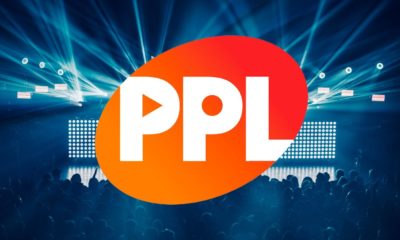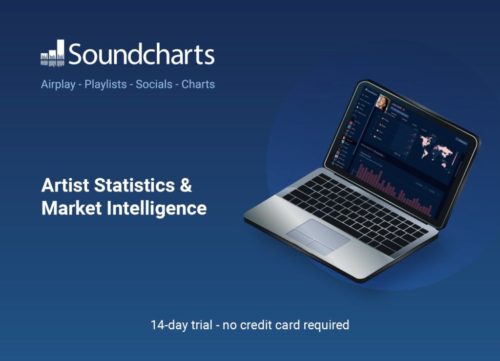News
Lizzo, Lionel Richie and more ask Trump to help Music Industry survive COVID-19
The letter, sent today, was also signed by Anderson .Paak, Gwen Stefani, and Tim McGraw.
Published
4 years agoon
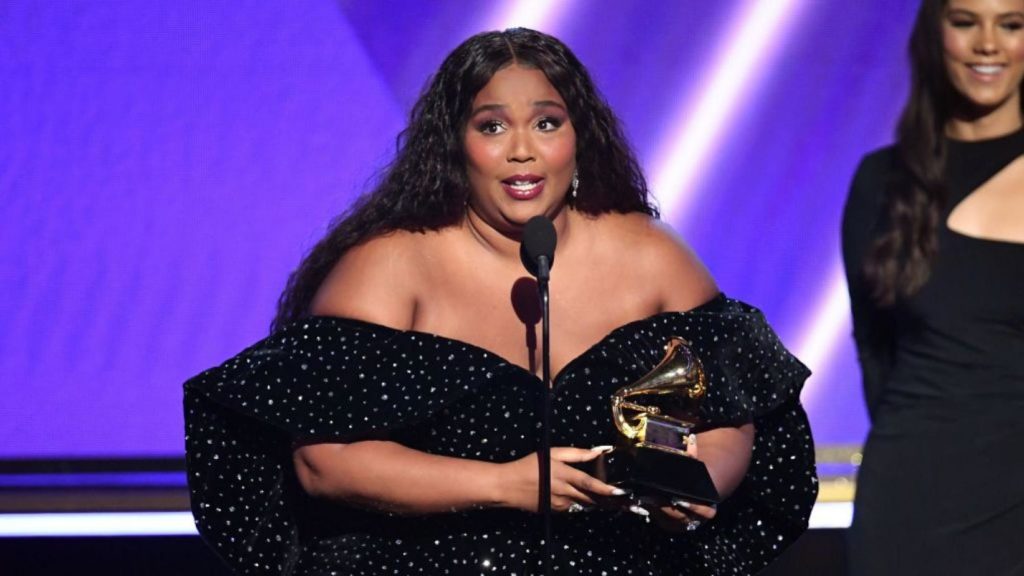
Story Highlights
- The letter was also signed by Diplo, Gwen Stefan, Tim McGraw and others
- Estimations state that $146m in income has already been lost (that number is expected to rise)
As each industry scrambles to find solutions to get through this uncharted territory caused by the spread of coronavirus, a group of prominent musicians are leaning on the United States government to lend support to help the music industry survive this epidemic. Today, the Music Artist Coalition (founded by industry veterans Irving Azoff and Dave Matthews) sent a letter addressed to the Trump Administration, asking for some sort of relief for the “hundreds of thousands of people whose livelihoods depend on the live music business“. The letter was co-signed by a wide range of successful mainstream artists, including Lizzo, Lionel Richie, Gwen Stefani, Anderson .Paak, Tim McGraw, Diplo – and countless others.
The mandatory cancelations of major live music events as a result of government restrictions has not only seen events like Coachella and SXSW rescheduled or canceled – but it has also had significant impact on the wider touring industry as a whole. Ranging from musicians, to dancers, background vocalists, audio / visual / stage production professionals, tour managers and beyond – there are countless people who solely depend on the live music industry to earn a normal living. To make a comparison of just how crucial the world of live music is – 2018 revenues for recorded music stood at $19.1bn, whereas live revenues brought in $27bn that same year. Much of that income goes to supporting those above-mentioned individuals who will essentially be out of work until this pandemic dies down.
Concerts are not just about the headliner
Music Artist Coalition Tweet
This was reiterated in the letter to congress, stating: Concerts are not just about the headliner”.
“The foundation of live music are the touring musicians, truck and bus drivers, stagehands, production teams, crews who handle lighting, sound, equipment, security, and so many others, who do not have any option for work as there are no live events for the foreseeable future.” it wrote.
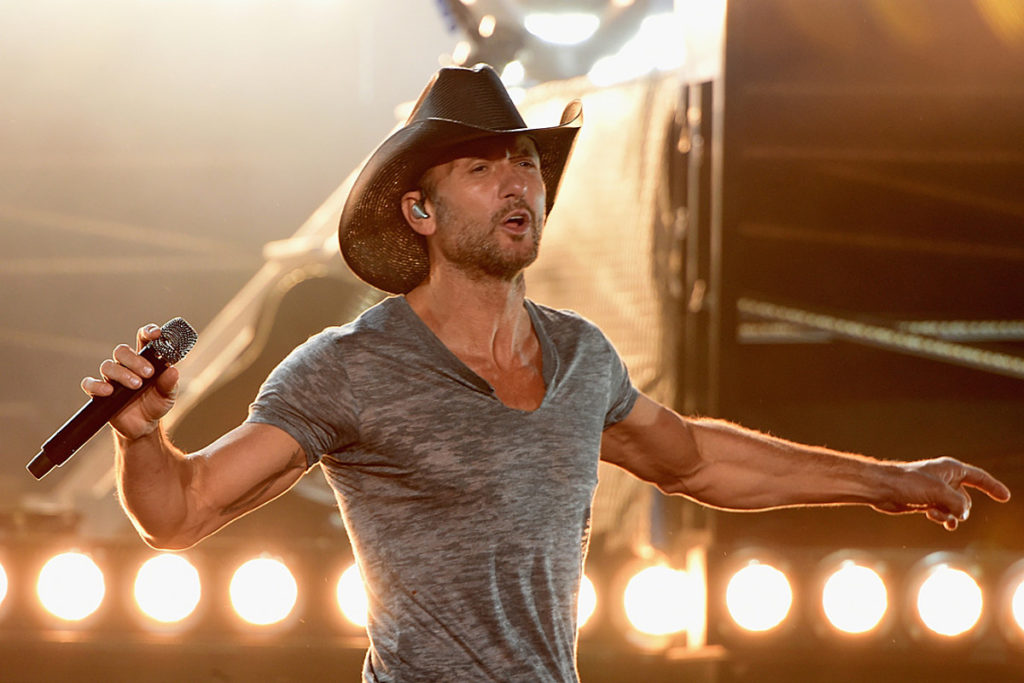
They go on to mention that the people in the music are “one of the groups most in need of government assistance” as they have had their business removed “without warning or a safety net“.
Whilst the U.S. government has yet to respond to this request, a number of music organizations and companies have offered financial relief to the music community – including The Recording Academy and Sound Royalties.
Internationally, Australian website ilostmygig.net.au has been setup exclusively for those across Australia and New Zealand who have and will be out of a salary due to touring cancelations. The website claims that $146m in income has been already lost – affecting over 470,000 people.
Trump has stated that there are plans to offer financial relief to affected Americans, but is yet to provide any details on a plan to distribute funds – or confirm who exactly they’ll be going to.
You can read the letter to the U.S. congress in full below:
Dear President Trump and Secretary Mnuchin,
The Music Artists Coalition (MAC) appreciates the bipartisan efforts underway to address the severe economic impact on millions of Americans because of COVID-19. As economic relief efforts are finalized, MAC believes it is essential that support is reserved for the hundreds of thousands of people whose livelihoods depend on the live music business.
In compliance with CDC guidelines, all concerts and events have been canceled indefinitely. As a result, the concert business is as drastically and negatively impacted as the airlines and the hospitality industries, despite a lack of media attention. The men and women who work tirelessly to bring live music to fans are unable to work from home and have no alternative means of supporting themselves and their families.
The cancellation of concerts, tours, and festivals means that the musicians and crews who make every concert a special experience for music fans are now out of a job and have no other way to pay rent or put food on the table. Concerts are not just about the headliner: the foundation of live music are the touring musicians, truck and bus drivers, stagehands, production teams, crews who handle lighting, sound, equipment, security, and so many others do not have any option for work as there are no live events for the foreseeable future.
The cancellation of concerts, festivals, and tours has brought an abrupt end to income for hundreds of thousands of people. For these dedicated individuals, it is not an unwillingness, but an inability, to work, when all concerts, tours, and recording sessions are canceled or indefinitely postponed. While some concerts will be rescheduled, it is inevitable that many will be canceled and unable to find a venue in which to perform when this crisis has passed.
The music industry is facing an existential threat that is unprecedented – the touring business as we know it has disappeared without warning and without a safety net for hundreds of thousands of people. MAC believes the impacted people in the music industry are one of the groups most in need of government assistance.
Thank you for leading the fight to ensure Americans are able to pay their bills and survive these trying times.
Sincerely,
Adam Dorn
Adrianne Duncan
Alex Sugarman
Ali Harnell
Alicia Spillias
Aloe Blacc
Amy Lee (Evanescence)
Anderson .Paak
Anthony Rossomando
Anthony Russo
Ari Herstand
August Roads
BANKS
Ben Rector
Bernie Taupin
Black Rebel Motorcycle Club
Bloque
Boombox Cartel
Brandon Robert Young
Brian Lee
Burt Bacharach
Charli XCX
Chloe Flower
Clare Bowen
Cody Tarpley
Cold War Kids
Coran Capshaw
Crywolf
Danica Pinner
Danny Parker
Dark Water
Dave Matthews
David Brownstein
David Murillo
Def Leppard
Deva Mahal
Diplo
Don Henley
Drew Holcomb
Dustin O’Halloran
Elizabeth Crbe
Elliot Grofman
FIDLA
Gabe Rosales
Garrett Edson
George Ritter
Grady
Gwen Stefani
Harlan Silverman
Idina Menzel
Irving Azoff
J Ross Parrelli
Jack Quinn
JC Dwyer
JD Souther
Jean-Pierre Durand
Jeff Russo
Jeffrey Rivera
Jennifer Nettles
Jeremy Silver
Jerrod Bettis (p/k/a “Skins”)
Jim Cicconi
Joe Walsh
John Mayer
John Silva
Jon Levine
Jonny Pierce (p/k/a “The Drums”)
Jordan Bromley
Jordan Davis
Jordan Palmer
Julian Casablancas
Karen Fairchild
Kat Dahlia
Kenny “Babyface” Edmonds
Kenny Loggins
Kerry Brown
Kimber Kristy
Kito
Kristen Foster
Kristian Bush
KSHMR
Kyler England
Larkin Poe
Leslie Odom Jr
Lincoln Jesser
Linda Perry
Lionel Andie
Lionel Richie
Little Big Town
Lizzo
Lostboycrow
Louis Bell
Louis Schoorl
Lucie Silvas
Lucy Levinsohn
Lunchmoney Lewis
MAG
Mandy Dickson
Maren Morris
Mark Ronson
MAX
Meghan Trainor
Michelle Lewis
Mitch Allan
Moana Avvenenti
Morgan Kibby/White Sea
M-Phazes
Nancy Kuo
Nick Seeley
Niia
NoMBe
ODESZA
Omar Waqor
Pat Monahan
Paul Stanley
Pepe Aguilar
Pussy Riot
Randy Belculfine
Robert Longoria
Rory Andrew (p/k/a “Wynne”)
Saint Astonia
Sam Martin
Sammy Witte
Sara Bareilles
Shane McAnally
Sheryl Crow
Showtek
Sirah
Slash
Slightly Stoopid
Spoon
Steve Jordan
Steve Miller
Steve Perry
Stevie Nicks
Stint
Stone Temple Pilots
Susan Genco
T Collar
The Doobie Brothers
The White Buffalo
Tim Lillis
Tim McGraw
Tom Meredith
Troye Sivan
Verdine White
Walk Off The Earth
Zach Dawes
Zach Sutton

MBN Staff
Analysis
Canada Slashes Kendrick Lamar’s Radio Play By 25%, While Drake Sees a 10% Decline In The U.S.
MBN Exclusive: New Soundcharts Data Shows The Cogs Working Behind Rap’s Hottest War.
Published
2 months agoon
Thursday, 6 June 2024 @ 20:51 EDT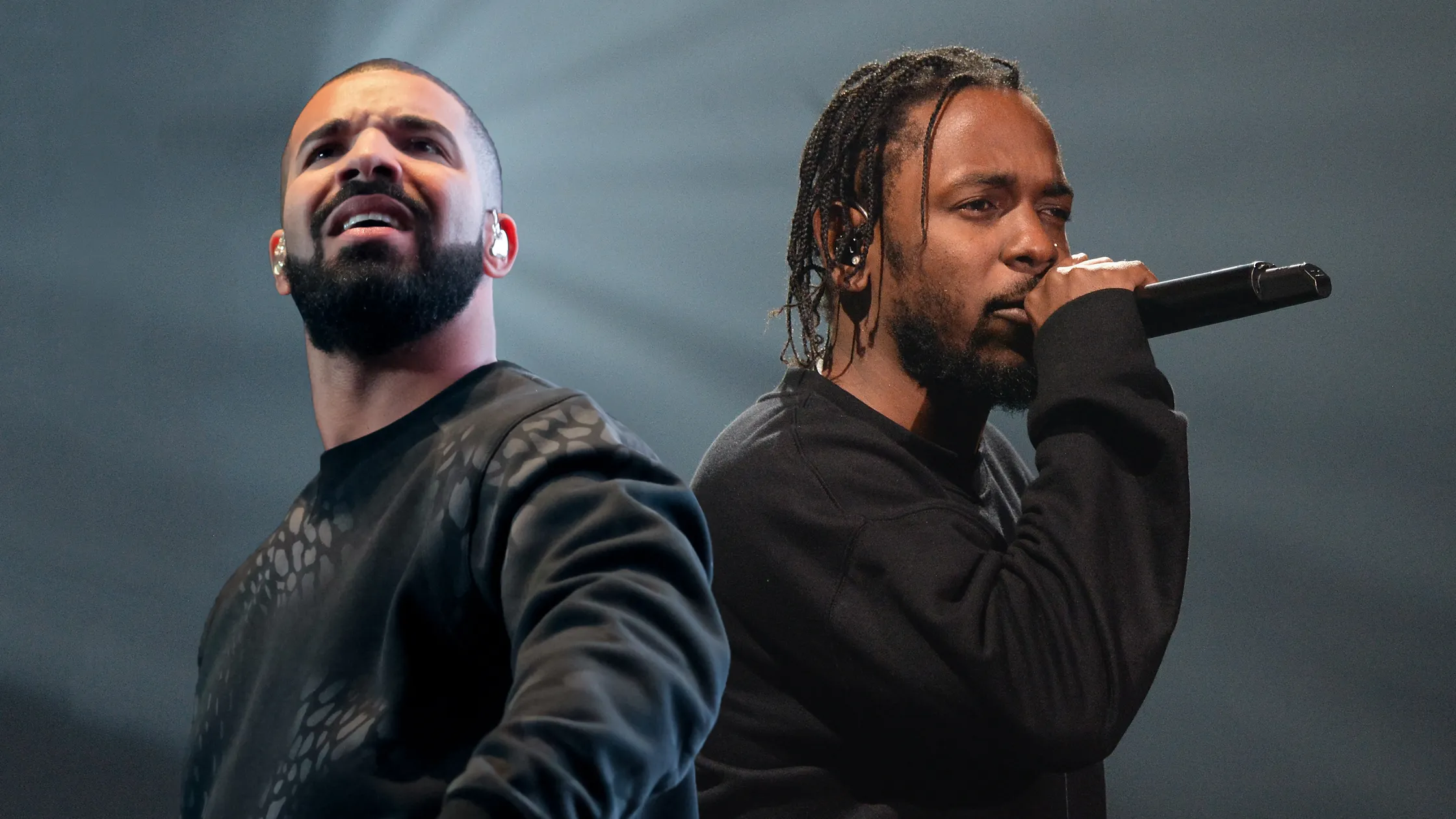
Story Highlights
New data provides unprecedented insight into the underlying methodology of the Drake-Kendrick feud crucial to understanding the broader battle for hip-hop supremacy.
Few rivalries in the high-stakes world of hip hop superstardom have captured the cultural zeitgeist as completely as the recent feud between ‘Rap Gods’ Drake and Kendrick Lamar. Being two of the genre’s OGs, their every move sent reverberations through the music industry and beyond. A lot of the conversation around the ‘slugfest’ revolved around the surface-level spectacle of the diss tracks and opinions among fans, but the real narrative that shapes this feud is the one presented in the data (the streaming numbers, radio spins and listener trends that provide an insight into the way the two superstars’ strategies prior to the ‘war of words’ helped them to navigate this war behind the scenes.
A Geographic Dividend
As we previously reported at Music Biz Nation, data from Luminate – a premier music analytics company – showed an slight difference in how Drake and Kendrick diss tracks were being consumed regionally versus internationally in comparison to their overall catalogs. In Kendrick’s case, American listeners were responsible for 62.2% of streams on his Drake diss tracks, 11.5% above his typical 50.7% U.S. share. Meanwhile, Drake saw only a small boost in U.S. streams for his Kendrick disses, bumping from 58.9% to 60.1% – with the remainder coming from international markets.
Getting more specific, Kendrick’s top listenership on Spotify stems from Los Angeles (also his top radio market), London and Chicago (all seeing a 2-3% monthly increase in the past month). Drake still comfortably maintained an 82.5 million to Kendrick’s 78 million in Spotify monthly listeners over the past 28 days, with his top markets on the platform being London, Los Angeles, and New York. Notably, Drake saw a 1-2% dip in listenership in all three of his top markets, while Kendrick gained ground in each of them.
The Streaming Showdown: Loyalty vs. Virality
In the wake of Kendrick’s numerous diss tracks, including the most popular of them all “Not Like Us,” (amassing 280 million streams and 2,000+ playlist placements on Spotify alone) his monthly Spotify listener count surged by an impressive 27 million. Drake, meanwhile, saw a comparatively modest dip of 1.5 million monthly listeners since the start of the feud, with his most popular Kendrick-diss “Family Matters” totaling a mere 66 million Spotify streams and 700 playlists on the platform. On the surface, this might suggest a clear win for Kendrick. However, a deeper dive into listener retention rates tells a more complex story.
Drake’s retention rate actually increased from 105% to 109% during this period, indicating that his core fanbase remains remarkably steadfast in their loyalty, even in the face of Kendrick’s onslaught. Additionally, Drake’s monthly listener count on Spotify, even after a 1.5 million dip, still towers over Kendrick’s but only slightly at 82.5 million to 78 million – a much closer gap than before the ‘war’.
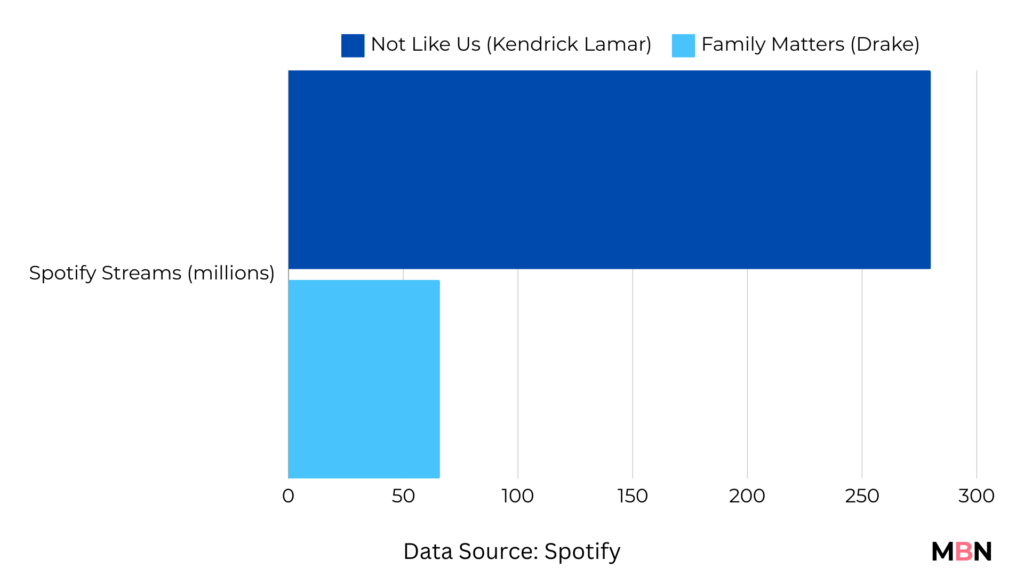
Kendrick, on the other hand, saw his retention rate plummet from 43% to 38%, suggesting that many of his newly-gained listeners may be more curious onlookers than devoted fans.
This data paints a picture of two contrasting strategies – one focused on cultivating deep, lasting loyalty, the other on generating viral moments and sparking widespread curiosity. While Kendrick’s approach may be winning the battle for short-term attention, Drake’s strategy could prove more effective in the long-term war for enduring dominance.
Kendrick’s cultural references in his diss tracks is likely what ignited and engaged more of his U.S. audience. Meanwhile, the strength of his overall catalog has allowed Drake to rely on his status as a global superstar, betting on the continued reliability of his massive global audience to absorb any blowback.
Radio Waves Shift: Kendrick's Domestic Surge
Soundcharts data also point to a change in radio play dynamics over the last month. While Drake’s radio spins dipped slightly in the U.S. (-9%) and U.K. (-6%) – two of his top markets – Kendrick Lamar has seen an 80% increase in U.S. radio play in the wake of feud. Lamar’s increased radio play in the U.S. was, unsurprisingly, driven by airplay of “Not Like Us” in the Los Angeles area (his home county) on stations such as Power106 and KRRL-FM Real 92.3 (responsible for Kendrick’s highest number of global radio plays over the last month).
Most tellingly, but somewhat expected, the LA-based Real 92.3, the station that has been Kendrick’s staunchest cheerleader, cut Drake’s airplay by a staggering 30% during the month of May.
This domestic dominant radio surge for Kendrick, coupled with the increase in U.S. streaming share for his diss tracks might speak to the effectiveness of his regionally-focused strategy in comparison to Drake’s. And with the U.S. being the biggest market for the Hip Hop genre, it is not difficult to see why a strategy like this has created such an impact in his battle with the Toronto-based rapper.
In Drake’s case, despite facing slight challenges in the U.S. radio market during the feud, the ‘6 God’ has managed to maintain his global radio dominance by making up ground key local and international markets in regions such as France (up 12%) and his home country of Canada (up 8%), where Kendrick has seen a 25% decline in airplay.
In saying that, like Drake, Kendrick has also compensated by making significant progress in other international radio markets over the past month – such as Nigeria (+104% in spins) and portions of Europe (U.K. +40%, Belgium +27%, Germany +26%, ).
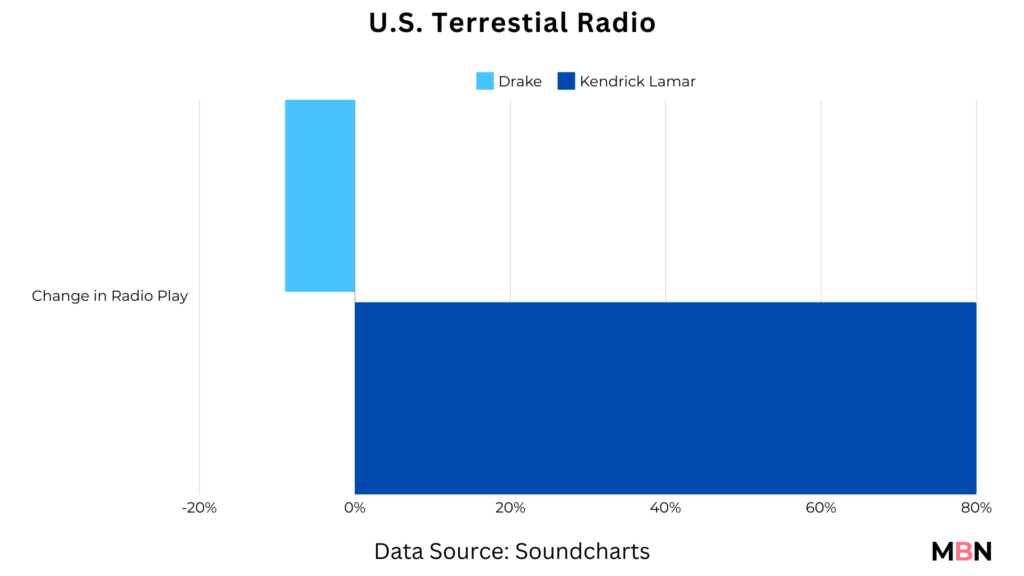
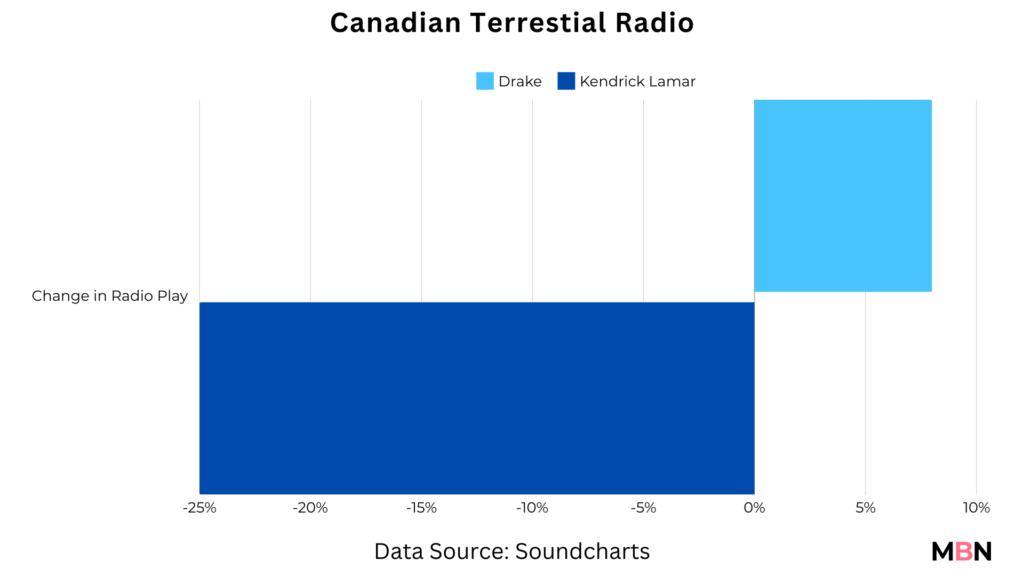
Kendrick's Viral Breakthrough: The TikTok Wildcard
Where Drake may be ahead in terms of the raw numbers of streams and spins of his overall catalog, when it comes to the virality of this feud, Kendrick has taken the crown by more than a mile.
In just one month after its release, “Not Like Us” was the soundtrack for 560,000+ TikTok videos and 1.4 billion views, quickly becoming his third most popular song on the platform as lead artist (surpassing “We Cry Together”, from his most recent album ‘Mr. Morale & The Big Steppers’). The uptick is arguably a testament to Kendrick’s ‘hidden’ ability to create a moment that lands with TikTok’s wide audience often moved by the winds of popularity – something Drake was more known for excelling at prior to the feud. Drizzy’s most popular TikTok song “Tootsie Slide” has amassed 2.8 million videos and 8.2 billion views, compared to Kendrick’s 1.1 million videos and 1.3 billion videos for his most popular TikTok song “HUMBLE”. Notably, “Not Like Us” has accumulated more TikTok views than “HUMBLE.” with half the number of videos, speaking to its undeniable cultural impact.
Drake’s most popular song in the ‘back and forth’ with Lamar, “Family Matters”, stands at just 1,800 TikTok videos and 7.5 million views.
In an era where a single viral moment can redefine an artist’s trajectory, Kendrick’s overwhelming TikTok triumph in this feud could be an extremely powerful weapon in his arsenal. If he can sustain this momentum and translate the buzz into lasting listener growth and engagement, it could dramatically redefine of his overall positioning. Should the feud continue in any way, this is a wildcard that Drake (despite his overall dominance) cannot afford to ignore.
Looking Ahead...
With all that said, one thing is clear: the Drake-Kendrick beef was much more than a rap beef. As the reams of data show, it’s a rich, multifaceted playbook for how different strategies can determine equally impactful yet completely different outcomes. Every artist has their own unique arsenal of strengths and strategies — Drake’s unbreakable global grip and resistance to wobble in the storm, Kendrick’s gift for the viral moment and local relevance — which we’ll continue to watch with his future releases.
Get weekly music biz updates straight to your inbox.

MBN Staff
Entertainment
Sony Reportedly in Talks for $1 Billion Queen Catalog Acquisition
Source says discussions between Queen and Sony Music over the British band’s catalog sale have been ongoing since last year.
Published
2 months agoon
Thursday, 30 May 2024 @ 13:46 EDT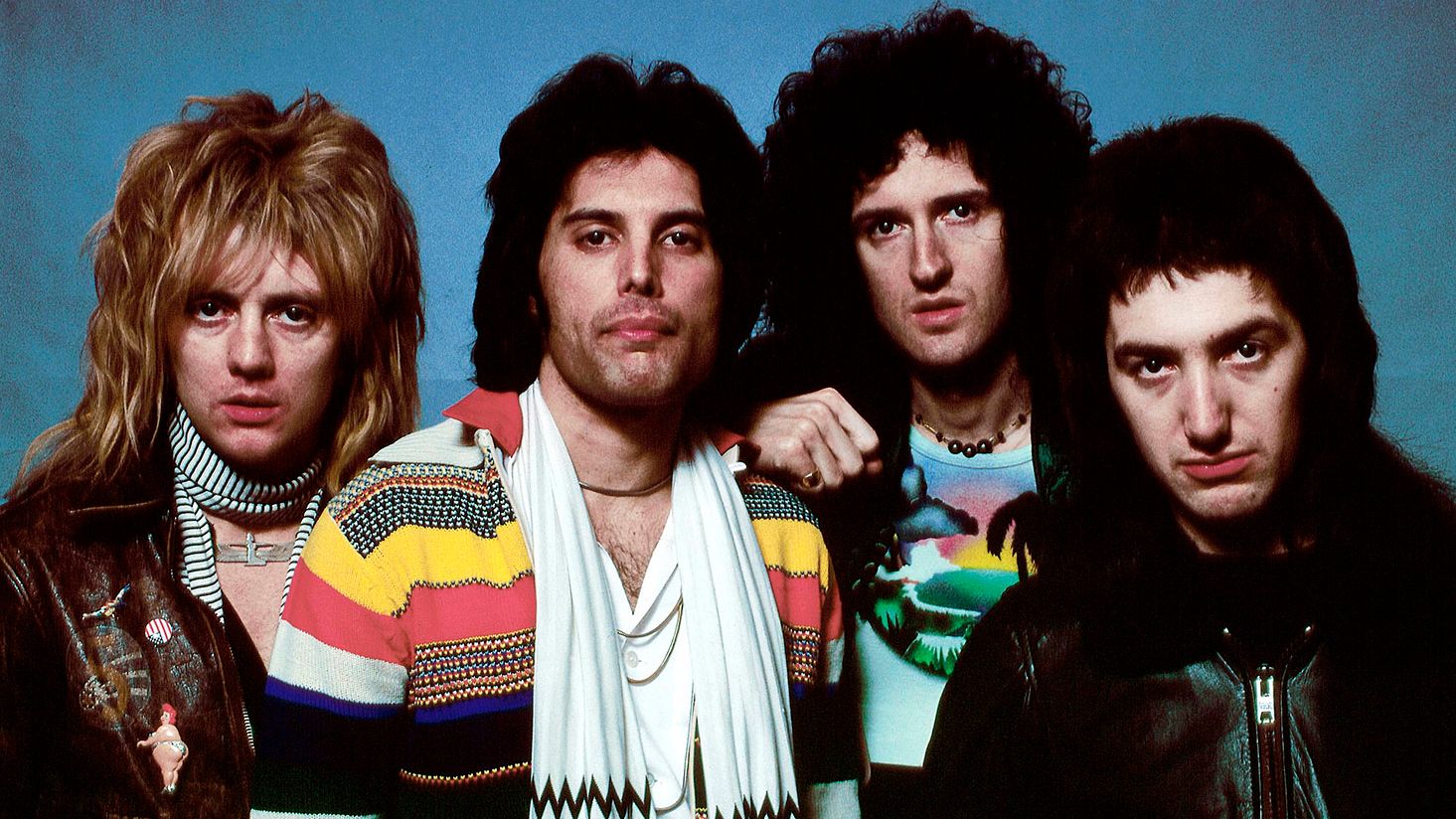
Story Highlights
Sony’s potential deal for Queen’s music assets could make it the biggest single-artist catalog acquisition in history.
According to multiple outlets, sources report that iconic British rock band Queen has been seeking a valuation of around $1.2 billion for its music assets, which consist of both publishing and master recording rights jointly owned by the band’s surviving members Brian May, Roger Taylor and John Deacon, as well as the Freddie Mercury estate. Bloomberg first reported that Sony Music is the undisclosed suitor currently in an exclusive negotiating window with Queen, working with an unnamed financial partner.
Music Business Worldwide originally broke news of the catalog being shopped for a 9-figure sum in May 2023, noting that major labels like Universal Music Group and private equity players had engaged in discussions.
Of course, putting together a deal of this magnitude and complexity, especially with multiple stakeholders involved, comes with no guarantee of closer. As a cautionary example, sources say Pink Floyd’s attempt to sell their catalog for $500 million collapsed in 2022 due to band members having differing priorities.
Inside Queen's Financial Performance
Music Business Worldwide also reported that Queen Productions Ltd, the UK entity housing the band’s recordings, reported £40.89 million ($50.41m) in turnover for the fiscal year ending September 2022, a 4.3% increase over 2021. Profit before taxes jumped 31.6% to £22.16 million ($27.41m).
Much of this growth likely stems from the popularity boost following the band’s 2018 biopic Bohemian Rhapsody. In fact, the FY2022 revenue figure more than tripled Queen’s £12.34 million turnover ($16.72m) in FY2016 before the film’s release. The band’s enduring appeal is further evidenced by the nearly 38 million album consumption units and 46 billion on-demand global streams their catalog has amassed since 1991, according to Luminate and reported by Billboard.
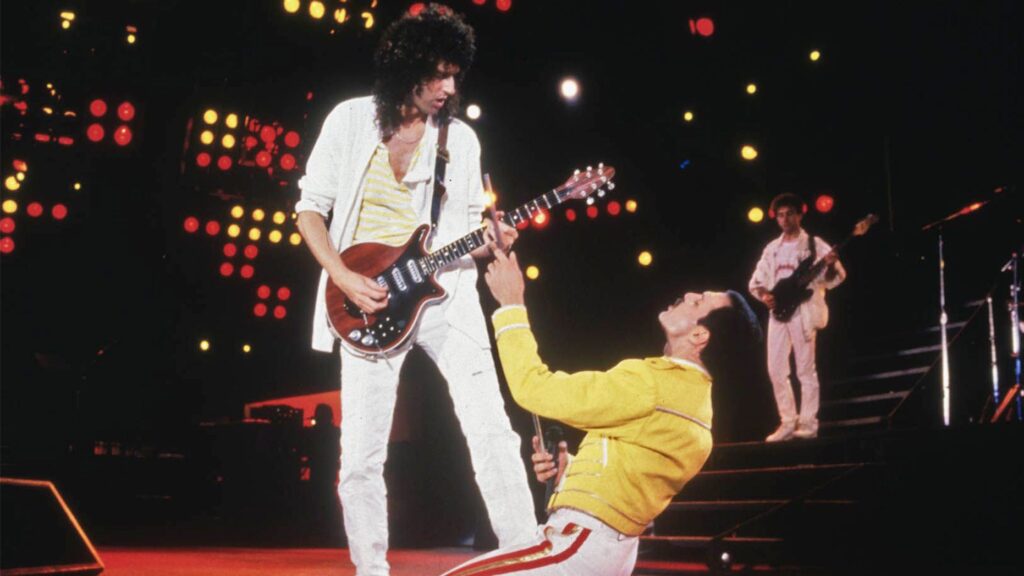
Implications of a Billion-Dollar Sale
If completed in the $1 billion range as reported, Queen’s sale would handily surpass Bruce Springsteen’s $500 million+ catalog deal with Sony in 2021 to become the biggest transaction for a single artist’s body of work. It would also dwarf the $600 million Sony allegedly paid in February for 50% of Michael Jackson’s catalog. Though, technically speaking, with only the remaining 50% sold, the deal with the Jackson estate valued the late King of Pop’s catalog at $1.2 billion – slightly above than the reported $1 billion offer of Queen’s work, if that number is exact.
However, Queen’s situation is a little more complicated due to Disney Music Group’s current rights to their master recordings in North America under the Hollywood Records umbrella. Any acquirer would need to navigate that structure and DMG’s global distribution pact with Universal.
The stratospheric valuations attached to evergreen hit songs have enticed artists to cash in on their life’s work, accepting a one-time capital gains tax rather than annual income taxes on royalties. But as the Hipgnosis Songs Fund has demonstrated, aggregating catalogs at premium prices fueled by cheap debt doesn’t automatically translate into strong returns. Blackstone’s takeover of Hipgnosis following a shareholder revolt underscores the potential risks of catalog acquisition sprees.
Queen, though, stands apart as one of the most commercially successful acts in history, notching six No. 1 singles and 10 No. 1 albums in the UK across five decades. With the right promotion and synch opportunities, dozens of their songs like “Bohemian Rhapsody,” “We Will Rock You,” and “Another One Bites the Dust” have the potential to generate substantial returns for decades to come. But at a $1 billion entry price, Sony or any other buyer will need to be confident they can unlock significantly more value to make the numbers work.
Get weekly music biz updates straight to your inbox.

MBN Staff

Canada Slashes Kendrick Lamar’s Radio Play By 25%, While Drake Sees a 10% Decline In The U.S.

Sony Reportedly in Talks for $1 Billion Queen Catalog Acquisition

Drake vs. Kendrick: How Their Diss Track Data Reveals Divergent Paths to Streaming Dominance

Albums Chart Data: Swift & Eilish Dominate UK & US Listings







